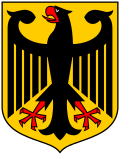Background
After the Nazi seizure of power on 30 January 1933, Adolf Hitler quickly set about taking control of all aspects of the German government and society. One of his first acts was to engineer passage of the Enabling Act through the Reichstag on 23 March 1933. This empowered the "Reich government" (i.e., the Reich Chancellor and his cabinet) to enact laws for a period of four years without submitting them for passage and approval to the Reichstag or the Reich President. Reduced to insignificance, the Reichstag would only pass seven laws over the next nine years. Armed with these sweeping new emergency powers, Hitler used them to enact a series of laws aimed at establishing his dictatorial control over the nation. One means to this end was to eliminate all opposition parties and ensure that the Nazi Party had complete dominance over the politics of the nation.
By the provisions enacted in the Reichstag Fire Decree, many civil liberties guaranteed to German citizens by the Weimar Constitution had been suspended, including the right of habeas corpus , and freedom of speech, the press and assembly. A campaign of intimidation and terror was then waged by the Nazi Sturmabteilung (SA), the Party's paramilitary force. The blows fell first on their fiercest opponent, the Communist Party (KPD), whose Reichstag deputies were banned from taking their seats, and most of whom were arrested and taken to concentration camps. The KPD had effectively been outlawed in all but name by the Reichstag Fire Decree, and was completely banned from 6 March 1933.
Following additional months of violence and intimidation against the Social Democratic Party (SPD), the government seized all its assets on 10 May 1933. On 22 June, they banned all Social Democratic publications and meetings, and canceled all SPD electoral mandates in both the Reichstag and the state Landtage (parliaments). Membership in the SPD was declared incompatible with holding public office or a civil service position. All over Germany, three thousand party functionaries were arrested, assaulted, tortured and confined in prisons or concentration camps. The SPD was effectively hounded out of existence.
By early July, all other parties, representing the broad German middle class, had been intimidated into dissolving themselves rather than face arrest and imprisonment. All the major parties of the Weimar Republic formally disbanded within the span of about a week: the German National People's Party, the Nazis' coalition partner (27 June), the German State Party (28 June), the Centre Party (3 July), the Bavarian People's Party (4 July) and the German People's Party (4 July).
Ensuring that the Nazi Party's hegemony was enshrined in law, the Reich government then enacted the Law Against the Formation of Parties on 14 July 1933. It declared the NSDAP the country's only legal political party, and mandated a punishment of imprisonment for anyone supporting or seeking to establish another party organization. The brevity of its three sentences belied the historical import of the action.
This page is based on this
Wikipedia article Text is available under the
CC BY-SA 4.0 license; additional terms may apply.
Images, videos and audio are available under their respective licenses.

